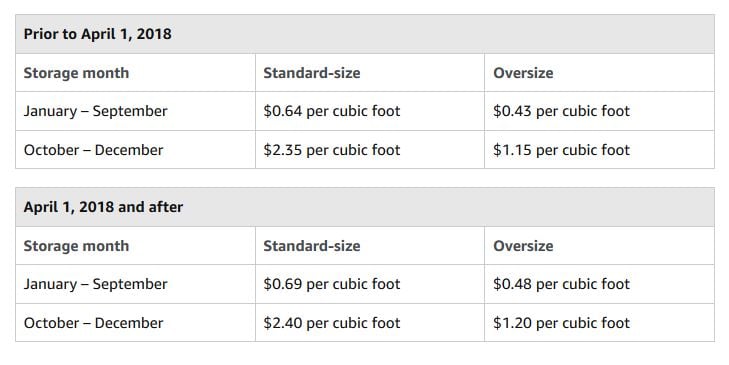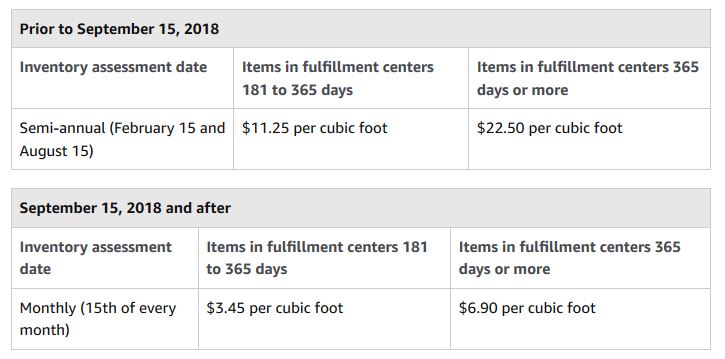Amazon is rolling out a major update to FBA fees by charging long-term storage fees on a monthly basis rather than biannually. Additionally, they are also making a small increase to monthly inventory storage fees and limiting access to storage for sellers with an Inventory Performance Index below 350. The changes to FBA fees are outlined below.
1. Monthly Inventory Storage Fees
Starting 1 April 2018, monthly inventory storage fees will be increased by $0.05 per cubic foot for standard-size and oversize items. This change will first be reflected in May 2018 charges for storage that occurs in April 2018.

See the Monthly Inventory Storage Fees section for more details.
2. Long-Term Storage Fees
Starting 15 September 2018, long-term storage fees will be adjusted, and the assessment dates will be changed from a biannual basis to a monthly basis.

See the Long-Term Storage Fees section for more details.
3. Minimum Long-Term Storage Fees
On 15 August 2018, Amazon will introduce a minimum charge of $0.50 per unit per month for items in fulfilment centres for 365 days or more. The greater of the applicable total long-term storage fee or minimum long-term storage fee will be charged.

See the Minimum Long-Term Storage Fees section for more details.
4. Inventory Performance Index Score
The Inventory Performance Index is Amazon’s first step in setting a bar on inventory performance.
Starting 1 July 2018, Amazon may limit access to storage for sellers with an Inventory Performance Index below 350. Your score is updated weekly based on your ongoing inventory management.
Sellers who maintain an index score of 350 or greater will have unlimited storage for standard size and oversize items (monthly storage fees and long-term storage fees still apply).
Amazon provides sellers with their Inventory Performance Index score and offers recommendations on how sellers can improve their scores in three main areas.
- Out of stock inventory
Amazon provides recommendations on what to restock and when. While staying in stock with the right ASIN can help increase a seller’s Inventory Performance Index, there is no penalty for not restocking a discontinued or non-replenishable item. - Excess inventory
Amazon offers a Manage Excess Inventory tool that helps sellers identify listings that may have excess inventory levels and provides data to help them get a better return on their investment. The tool highlights factors that may be limiting sales, suggests actions that initiate faster sales, and suggests a recommended sale price. It also gives recommendations like improving keywords, editing listings, and reducing costs through removals. - Stranded inventory
This is inventory in fulfilment centres that doesn’t have an associated active offer – it means products that are sitting on warehouse shelves but cannot be sold because they aren’t associated with any offers on the Amazon website.
See the FBA Storage Limits Changes section for more details.
For more information on any of the changes covered, check out Seller Central or contact Amazon directly.
FBA Seller Stephen Smotherman’s Thoughts
Stephen from Full-Time FBA offers his thoughts on what the Amazon fee increases and storage limits means for sellers.
- Amazon wants me to send in better, faster selling inventory to their FBA warehouses. And, that’s a good thing!
- Amazon wants me to manage my inventory better. That, too, is a goal for my business.
- Amazon wants me to price my inventory better. One way to sell my inventory quicker would be to reprice more consistently using repricing software so that my prices stay competitive.
- Amazon wants me to remove old inventory on a regular basis, not twice a year. I expect the changes to benefit our inventory and our sales over the long run.
- If your FBA business model depends on long-tail items, you will need to work more ROI into your sourcing parameters to make up for the fees. Additionally, you will need to stay on top of your inventory health to make sure you remove items as necessary.
- 2018 is going to be a year of transition. With any changes, you can expect growing pains but if you remain flexible these changes can lead to overall growth in your business.
Final Thoughts
These changes aren’t happy today or tomorrow. Amazon is giving sellers plenty of time to make plans for the new changes. Our advice, don’t wait until July or August to figure out a strategy for long-term storage fees or dealing with the Inventory Performance Index — start working on solutions now.
One of the things the changes tell us is that Amazon wants sellers to price their inventory better and more consistently. For help with competitive pricing and avoiding long-term storage fees, check out RepricerExpress, Amazon and eBay repricer.
- Free 15-day Trial
- Win More Buy Box
- Avoid Long-Term Storage Fees
- No Credit Card Required

Related reading





